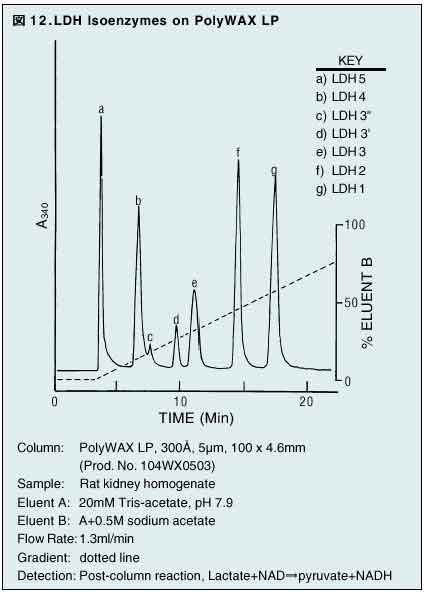PolyWAX LP HPLC Columns Operating Instructions
PolyWAX LP HPLC Columns Operating Instructions
For your convenience, we accept Mastercard,
VISA, and American Express credit cards.
| Home
| IdeaBook
| Orders
| Price/Applic
| Price/Vendor
| Protocols|
Conditioning new columns before use
PolyWAX LP weak anion exchange columns are packed with silica-based materials crosslinked with linear polyethyleneimine. Ideal for both large and small molecule proteins and potentially useful for organic acids and oligonucleotides, this column offers high capacity and superior results, and with proper care will last for hundreds of hours of operation.
PolyWAX LP columns are shipped in methanol. (Mfg. Instruction Sheet)
The following are instructions for conditioning new columns to ensure good results:
1. Flush with a minimum of 40ml H2O.
2. Elute the column with a strong salt solution (for example 0.2M NaH2PO4 + 0.3M NaOAc) for one hour.
3. Condition with two injections of an inexpensive protein solution.
By flushing the column with water in step one above, the hydrophilic coating adsorbs a layer of water and swells, increasing surface area and capacity, and causing a slight, irreversible increase in column backpressure. This reaction is hastened by running the salt solution. Because new columns may adsorb a small amount of protein in a nonspecific manner (it is thought this is a result of the scintered metal frits) it is recommended that you run two injections of an inexpensive protein solution, especially if you are running dilute or expensive samples.
Instructions for day-to-day use
It is recommended that you filter all mobile phases and samples to avoid plugging of the inlet frits even though they are easily replaced.
1. Flush with 10ml of a high salt buffer.
2. Condition with a low salt buffer.
3. Perform analysis(es).
4. Flush with 30-40ml H2O at end of day and plug the ends.
5. Store in H2O for up to 4 days. If the column is to be stored for longer than 4 days, store in methanol. When it is to be used again after methanol storage, prepare the column as described in "Conditioning new columns" to reproduce earlier results.
Protocol for protein separations
Anion exchange of proteins is typically done in pH range 7.0-8.5 with either ascending salt or decreasing pH gradients. The higher the pH, the stronger the binding of the protein. In this pH range, Tris HCl has proven a successful buffer.
To generate the salt gradients, acetate salts are successful as an alternative to halides which may corrode stainless steel. However, if you intend to monitor absorbance below 235nm, you may have to use chloride, and as a result you should flush the column with a minimum of 40ml deionized H2O at the end of the day.
Loading capacity for an analytical column, although dependent on how strong the protein binds to the support, is generally 2-5mg protein/injection.
The Nest Group does not recommend using a pH >7.0 since all silica based materials will dissolve. However, using a silica saturation column (part number 101GCC104 and column holder GCH 4FS) will prolong column life at a pH >7.0 if you choose to work in that pH region.
Typical anion-exchange HPLC separation of proteins
The majority of proteins have isoelectric points below 7 and are best purified or analyzed by anion-exchange chromatography. This chemistry, specifically developed for HPLC separation of enzymes, small molecules and other proteins, offers high and in some instances quantitative recovery of applied activity. This exceptional performance and greater selectivity results from the linear PEI crosslinked coating on the silica's surface--different from the more common branched polymer coating.
Used with salt gradients similar to those employed with DEAE-materials, the material is compatible with most organic solvents, and buffers of pH 7-8 are commonly used.
PolyWAX LP has a standard pore diameter of 30nm or 100nm and is available in particle diameters of 5, 7, and 15-20 microns.
See PolyWAX LP for Part Numbers and Prices.

Copyright© 1995-2024 The Nest Group, Inc.™ All rights reserved (established 1984)
For more information or to place
an order contact:
The Nest Group, Inc.™ 17 Hayward St., Ipswich, MA 01938-2041 USA
Tel: 1-508-481-6223
Fax: 1-508-485-5736
For your convenience, we accept Mastercard,
VISA, and American Express credit cards.
| Home
| IdeaBook
| Ordering
| Price/Applic
| Price/Vendor
| Protocols|
If you have problems or comments concerning
our WWW service, please send an e-mail to
webmaster.
About Us | GDPR Privacy Policy | Trademarks | Contact Us
Last Updated: 08/20/21


